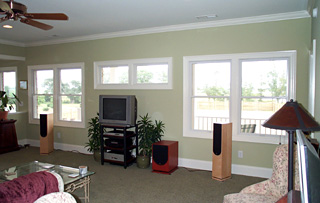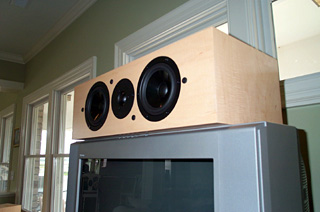![[SoundStage!]](../sslogo3.gif) Surrounded! Surrounded!Back Issue Article |
|||||
October 2003 Super Soliloquy Surround Speaker System
Talk about long overdue: Soliloquy Loudspeaker Corporation’s loudspeakers are built about two hours from my hometown, making the company neighbors of mine, but I’ve never heard the speakers in my home. In addition, the Raleigh, NC-based company has recently opened a new production facility where their products are built, tested, and shipped, so it’s clear they’re growing. I’m a reviewer -- it’s my job to pay attention to these things. I decided to quickly rectify my oversight, so I requested a review system from the company’s president, David Berman, to write about in "Surrounded." After all, I’m always on the lookout for products with a solid reputation for fine music making -- which Soliloquy certainly has. Why Soliloquy for "Surrounded"? I don’t believe that speakers should sound great with music and terrible with home theater, or vice versa. But there’s no denying that a designer can optimize a product for certain functions. For instance, there are home-theater speakers on the market that were designed for massive output capabilities to achieve THX-type playback levels. There are also speakers out there that are quick, agile, and transparent, but that can’t play at the levels needed for U-571’s depth-charge scenes. Perhaps if you have enough money to throw at your system you can buy a speaker system that has very few tradeoffs, but not everyone is going to spend the cost of a European luxury car on their multichannel music system. Knowing these tradeoffs exist can keep designers and reviewers up at night. It was therefore a pleasure to see a fine set of objectives met with the Soliloquy system that I will talk about here. On the surface, the list of what you get for your money is quite impressive: very solid slim-line cabinets finished in a variety of real-wood veneers; solid-metal gold-plated binding posts mounted in heavy, steel inset backplates; aluminum outrigger-style brackets and cones for lateral stability; nicely styled grilles with rounded bottoms for just a touch of elegance; and last but not least, performance that will do those SACDs and DVD-Audio discs justice. Technical notes Before I get ahead of myself with how these speakers sound, though, there are a few technical details about them you just have to know. The system assembled here consists of four $2199-per-pair USD 5.3 floorstanding speakers (7 1/2"W x 38"H x 11"D and 80 pounds) for main and surround duties, an $899 C-3 center-channel speaker (24"W x 7.5"H x 11"D and 35 pounds), and a $1699 S-10c subwoofer (13"W x 18 1/2"H x 18"D and 107 pounds). There are larger and smaller Soliloquy speakers that you can substitute for the fronts and rears, but the 5.3s were chosen because they provide a nice balance between size, price, and low-end extension. The magnetically shielded 5.3 and C-3 each use a 1" silk-dome tweeter and two 5 1/4" "poly-fiber" woofers. Instead of the midrange-tweeter-midrange configuration you see so often these days, the 5.3 has its two woofers mounted below the tweeter, while all the drivers are placed up high on the narrow front baffle. The bass-reflex port is located on the rear face. The C-3 differs from the 5.3 in that the tweeter is centrally mounted with flanking woofers. The 5.3s have a rated sensitivity of 90dB, while the C-3 is spec’d at 89dB. The S-10c is styled similarly to other subwoofers I’ve had through the house: front-mounted woofer, rear-mounted control panel, with a rectangular vent on the lower front face. The 10" woofer has a large rubber surround that imparts a look of ruggedness. All five sides of the S-10c’s cabinet are veneered (the exception being the bottom, of course, which is separated from the cabinet proper by the front-facing vent). Although the S-10c is not miniaturized the way the Sunfire models are, it’s also not coffin-like. When I unboxed the S-10c I thought to myself that it was proportioned very nicely relative to the rest of the system -- and a typical living room. You can place it in a number of fairly tight places, but it’s not a little wimpy sub that can go in your pocket when not in use. The S-10c has an internal 225W class A/B amplifier, variable phase and crossover controls, and speaker- and line-level inputs and outputs. Frequency response, as rated by the manufacturer, is down to 22Hz. A word about setup I placed all the speakers in the array approximately 12 feet from the listening position. This obviated the need to use any time-delay adjustments for any of the software types I listened to. I have Nordost cabling routed throughout my room, with Niles binding-post-equipped wall plates mounted on the rear wall. Banana plugs were used for each connection -- and they found a snug fit in the Soliloquy posts. The posts are too wide for dual plugs, however, so make sure you don’t require this in your setup. The electronics were an Esoteric DV-50 universal audio/video player, Coda v10 and 10.5r amplifiers (delivering 100Wpc each), and an Orpheus Laboratories Two multichannel preamp. Multichannel sound The very first thing I noted upon firing up this system was the amount of deep, full bass the 5.3s were capable of. They sounded much bigger than they were with SACDs like Telarc’s rendition of Mahler’s Symphony No. 5 (Benjamin Zander, conductor; Philharmonia Orchestra [Telarc SACD-60569]). The finale -- starting around 14:56 in -- is thrilling in its scale and majesty. You don’t have to worry about the common scenario where the satellite speakers run out of gas before passing the baton to the subwoofer. In fact, in some installations I’d hazard that the S-10c would be simply icing on the cake -- the 5.3s are so capable down low that you just don’t miss much even with the subwoofer disabled. How they get all that bass out of itsy-bitsy 5 1/4" drivers is a mystery, but who’s arguing? Now don’t get me wrong -- I like having prodigious bass capabilities. With the S-10c doing its thing with the low-frequency-effects track, the system took on a super-sized character that filled my large room to the hilt. Listening to Tchaikovsky’s 1812 Overture [Telarc SACD-60541] almost brought my wife to tears -- not because she likes the music that much, but because her Wedgwood collection was rattling on the shelves. The S-10c could both pressurize the room and punch me in the chest; that’s a nice balance for a variety of software. The moral to these observations is that although this isn’t one of those huge home-theater-type systems with 15" woofers powered by 2000W amplifiers, you do get generous output capability in the area that most systems run out of steam: the bass. So whatever your bass-laden poison, fire away -- the Soliloquy system has the answer for whatever music you’ll likely listen to. A perfect partner for all that bass was a simply huge soundstage. It does help that I had plenty of space between me and the speakers, which is necessary for the best in multichannel blending, but what was striking was the system’s ability to completely engulf the room with immersive, enveloping sound. A fine example was the stunning Sinatra at the Sands [Reprise R9 73777]. Not only did the speakers disappear, but they vanished into a seemingly cavernous space. You’ll love what this system does for large-scale works and ambient-sound-filled recordings. The fairly dry vocals on the Sinatra disc were also reproduced cleanly by the C-3 -- Old Blue Eyes would have been proud. This is a DVD-A you simply have to hear in multichannel to appreciate its liveness factor.
You also have to hear the silky-sweet highs these speakers are capable of producing. The treble range is delicate and smooooth. It’s the kind of sound you can just sink back into and enjoy for hours. If you’re after laser-beam-like precision and hyper-detail, you’ll probably not cotton to the sound of this system. It won’t point out every flaw in the recording or cut through the air like a hot knife through butter. It’s not as resolving as the best I’ve heard, either. But if you want to settle in with some coffee and be soothed by the clean sound of SACD and DVD-A without the downside of overly bright speakers, you’re in for a treat. Summation Most folks, not us crazy audiophiles, have criteria beyond simple sonic perfection. Oh, they like good sound, but other factors come into play, too. The Soliloquy 5.3s are compact, finely finished speakers that will blend into any conceivable decor. The available wood finishes include cherry, maple, and mahogany, any of which makes a nice statement in rooms with real furnishings. But they don’t sound compact at all. They produce a sound larger than they should. Maybe most important is what these Soliloquy speakers don’t do: You’ll not find a harsh tone in their being, which will serve well those occasionally abrasive soundtracks from Blockbuster Video. (I don’t know anyone that uses a multichannel music system for music alone.) Also, the bank won’t completely break when you buy this system. The price of this setup is beyond what you’ll spend at Circuit City, but the speakers are several cuts above in every respect as well. This the sort of speaker system that I can run out and tell my friends about. ...Jeff Fritz
|
|||||
|
|||||
![[SoundStage!]](../sslogo3.gif) All Contents All ContentsCopyright © 2003 SoundStage! All Rights Reserved |
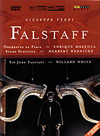 This stage production of Falstaff
is filled with rich, full-bodied sound. This is a good disc for those of you just
getting comfortable with multichannel performances. The surrounds are used rather
sparingly, with a focus on rear-hall ambience instead of all-round excitement as with so
many DVD-Video releases. Vocals are projected well out front for clear intelligibility.
Surprised by a less-is-more approach from DTS? Don’t be -- this is very well done.
Make sure you choose the surround mix in the menu; PCM stereo is the default.
This stage production of Falstaff
is filled with rich, full-bodied sound. This is a good disc for those of you just
getting comfortable with multichannel performances. The surrounds are used rather
sparingly, with a focus on rear-hall ambience instead of all-round excitement as with so
many DVD-Video releases. Vocals are projected well out front for clear intelligibility.
Surprised by a less-is-more approach from DTS? Don’t be -- this is very well done.
Make sure you choose the surround mix in the menu; PCM stereo is the default.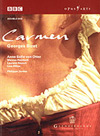 Carmen opens with a more
bombastic sound than Falstaff. Dynamic range from the DTS-encoded soundtrack is
impressive, with a crisp and punchy sound that never gets harsh or brittle. Although at
times the vocals can sound a bit subdued, the overall presentation of what must be
the most accessible of operatic stories is passionate. The ambient sounds emanating from
various points on stage will give the listener a chance to hear the subtleties in this
excellently produced surround recording.
Carmen opens with a more
bombastic sound than Falstaff. Dynamic range from the DTS-encoded soundtrack is
impressive, with a crisp and punchy sound that never gets harsh or brittle. Although at
times the vocals can sound a bit subdued, the overall presentation of what must be
the most accessible of operatic stories is passionate. The ambient sounds emanating from
various points on stage will give the listener a chance to hear the subtleties in this
excellently produced surround recording. 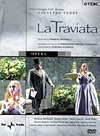 La Traviata is another
delicately balanced release. You’ll get a more mid-hall perspective on this recording
than with many DVD-Video releases, which, like the Falstaff above, will suit many
used to hearing opera in stereo only. The orchestra is cleanly recorded, which lends good
instrumental separation and overall clarity. As a plus, the video quality is strikingly
good.
La Traviata is another
delicately balanced release. You’ll get a more mid-hall perspective on this recording
than with many DVD-Video releases, which, like the Falstaff above, will suit many
used to hearing opera in stereo only. The orchestra is cleanly recorded, which lends good
instrumental separation and overall clarity. As a plus, the video quality is strikingly
good.